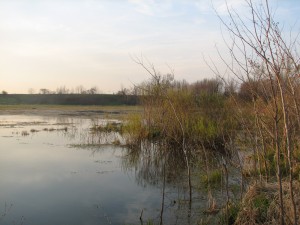We are very proud to present an overview of the hundreds of acres of wetland and upland habitat restored by the Wisconsin Waterfowl Association in 2013.
Please click here to view the slideshow of our 2013 habitat program overview

It’s important for everyone to understand the impact and relevance our work has on a broader landscape. The work WWA does, which you, as members, financially support, pays huge dividends to not only water quality but also to the wildlife habitat these wetlands support. Take a few minutes and see how these past projects which have positively impacted a wide and diverse set of goals. Wetlands play an integral role in the ecosystem far beyond waterfowl, which is why WWA has developed and implemented an ecosystem based approach to its wetland restoration projects. Working throughout the state for 30 years, we have appreciated partnering and working with over 50 other organizations to create viable restorations on thousands of acres of wetlands, streams and prairies. All three of these landscape types play an important role when you look at a project on the ecosystem scale.
WWA has been fortunate to implement many of its ecosystem based restoration projects where they directly benefit area watersheds. For example, last year the establishment of over 100 acres of native grass came about when WWA joined forces with our longtime partner USFWS to take full advantage of grant funds WWA had to offer. USFWS was able to use a portion of the grant funds to plant a warm season native mix on private land. This grassland cover is extremely important for water quality and wildlife as it holds soil in place, creates a diverse habitat which supports a broader range of species and reduces runoff. The promotion of available funding through grants and fundraising efforts is one way we have built partnerships and restorations.
WWA continuously works with private and public landowners. Wetlands have been drained for years in our state, negatively impacting our rivers and wetland habitats. Restoring a ditched and drained natural kettle basin results in many benefits for watersheds. The natural topography is restored and sediment is removed, hereby resulting in a 10 acre emergent marsh on one such project. This marsh now retains water year-round, storing it during flood periods instead of discharging it into the Milwaukee River. It helps mitigate flooding while producing a high quality habitat and recharging groundwater. Private landowners can receive technical and cost-share assistance from WWA through our habitat program.
One of the most publicly visible projects completed by WWA is the restoration of wetlands and Trinity Creek at the Mequon Nature Preserve (MNP). Working with multiple partners, WWA headed the restoration of the wetlands at MNP. The removal of miles of drain tile, ditches and tons of sediment from historic wetland areas has resulted in 25+ acres of wetlands. These types of restorations greatly improve water quality through the reduction in sediment from erosion and decreased nutrient inputs from runoff. They also help mitigate flooding with the removal of artificial drainage, allowing the soil to store tons of water naturally where plants can utilize it. With quality restorations and good partnerships we continue to develop opportunities to further wetland restoration at MNP and throughout the state through these broadening partnerships.
It’s also important to note that WWA restoration work meets many of the water quality issues that are of high importance to a broad group of organizations. Our work directly impacts almost all aspects of water quality, benefiting so many goals set at local, state and federal levels.
Peter Ziegler – Project Director – wwawetlands@gmail.com
